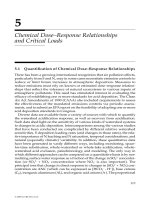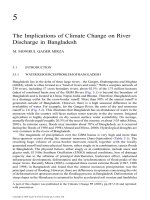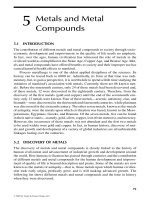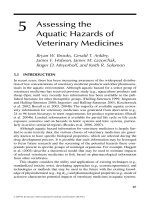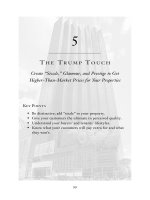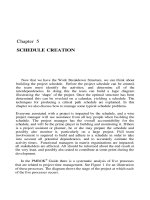Hedges on Hedge Funds Chapter 5 pdf
Bạn đang xem bản rút gọn của tài liệu. Xem và tải ngay bản đầy đủ của tài liệu tại đây (130.34 KB, 10 trang )
CHAPTER
5
CHAPTER 5
Does Size Matter?
T
o what extent does a hedge fund’s growth and size affect its prospects
for maximum performance, and how does this affect its investors?
Investors need to model their investment portfolio to ensure proper
diversification among strategies, yet the findings of a recent study show
that investors also need to evaluate funds of all sizes when making hedge
fund allocations. Although the tendency may be for investors to believe
that “bigger is better” and to invest with the large, high-profile funds, that
is not always the right move.
The study’s implication is that small funds tend to outperform larger
funds and that medium-size funds typically fare the worst. Therefore,
manager selection should be biased toward those hedge funds that are
nimble and responsive and that generate alpha. Smaller funds can put
all of their money into their best ideas; larger, more senior funds often
find it difficult to put continued inflows to work due to the constraints
of internal asset allocation guidelines and policies.
The number of hedge fund managers is up from approximately
1,000 in the late 1990s to more than 6,000 in 2003, which makes it
increasingly important to rely on rigorous due diligence when selecting
the best-performing managers within the various investment styles and
strategies. Although the number of managers has grown overall, the ratio
of hedge fund start-ups to closings within the hedge fund industry gen-
erates concerns over basic issues related to back-office operations, trans-
parency, capacity, and style drift, many of which have been discussed in
65
c05_hedges.qxd 8/30/04 12:02 PM Page 65
previous chapters. While approximately 700 to 800 hedge funds closed in
2002, another 800 to 900 new firms began operations.
The question regarding the link between portfolio size and dimin-
ishing returns evolved from observations of top hedge fund managers in
large funds, such as Tiger and Soros, who left to start successful hedge
funds that closed to new investment at $500 million or $1 billion, which
is far smaller than the funds where they began their careers. At its peak,
Tiger had reached $22 billion, and Soros had reached $23 billion.
As background, consider that as a group, hedge funds are relatively
smaller than their financial counterparts when measured in terms of
assets, staff size, and years in business. During the three-year period
between 1999 and 2001, LJH confirmed that size distribution remained
fairly constant with slightly more than half of all hedge funds smaller
than $25 million, approximately 80 percent of hedge funds smaller than
$100 million, and 5 percent of all hedge funds larger than $500 million.
(See Figure 5.1.) Although many investors do not consider investing
with firms smaller than $50 million, the data support the view that these
are indeed strong-performing funds.
66 HEDGES ON HEDGE FUNDS
1999
2000
2001
35
30
25
20
15
10
5
0
<5m 5–25m 25–100m 100–500m >500m
Number of Funds (%)
Size bucket (US$m)
FIGURE 5.1 Size Distribution of Hedge Hunds.
Source: Van Hedge Fund Advisors.
c05_hedges.qxd 8/30/04 12:02 PM Page 66
Does Size Matter? 67
According to the 2002 Putnam-Lovell paper on the possible institu-
tionalization of hedge funds, statistical observation suggests that the dis-
tribution of hedge funds by size continues to trend downward slightly.
The average hedge fund size is $87 million with a median base of $22
million. The implications of this might be an increase in niche opportu-
nities and new strategies, as well as a possible change in allocation pol-
icy to smaller, more nimble managers.
ADVANTAGES AND DISADVANTAGES OF A LARGE ASSET BASE
Advantages of a large asset base include more resources for research,
increased ability to attract and retain investment talent, increased effi-
ciency in brokerage, better access to companies, and greater bargaining
power with broker/dealers.
However, challenges remain as to how to find alpha and identify the
next generation of stars, which is a vital concern due to the fact that
larger hedge funds also have significant disadvantages. Liquidity costs,
for example, are significant, and smaller funds are able to put all of their
money into their best ideas. Getting in and out of trades can be more
difficult for the larger funds, especially with respect to their reduced
ability to short. To compensate, suboptimal investment tactics may have
to be adopted. Slippage also may occur with large orders.
Also worth noting are the psychological fears and career risks that
can emerge as funds grow. Managers may test their limits by continuing
to take in new money and increase their level of risk in an effort to boost
returns. However, this may lead to growing concern over reputational
risk, including possible dismissal or bankruptcy if the fund suffers.
Organizational diseconomies are also evident. Managing money is differ-
ent from managing people and managing a business, and the quality of
personnel is difficult to maintain as fund size grows.
METHODOLOGY
Our study reviewed verifiable, “clean” data from 268 hedge funds in six
strategies, each of which had monthly returns and assets under man-
agement continuously available for the time period of January 1995
c05_hedges.qxd 8/30/04 12:02 PM Page 67
68 HEDGES ON HEDGE FUNDS
through December 2002. Realizing that many past hedge fund studies
traditionally have been incomplete, inaccurate, and prone to suffer from
a number of biases, the research team focused on a small-sample size
with the characteristics of a stratified sample from within the hedge
fund universe. The sample included both funds that stopped reporting
and funds that started operation during the same period, which ranged
from January 1995 to December 2001.
With the goal of determining whether smaller funds outperformed
larger funds, we measured three size-mimicking portfolios of equally
weighted, monthly returns. We classified funds based on assets under man-
agement into three buckets, small (less than or equal to $50 million), me-
dium ($50 million to $150 million), or large (more than $150 million).
Because assets under management are usually updated at year-end,
the study measured performance beginning in January and then repeated
the measurement each January thereafter for the duration of the study.
Managers who entered the database during the year were allocated to
one of three portfolios based on initial assets under management, and
the portfolio was rebalanced accordingly. “Dead” funds remained in the
portfolio until the month of their last reporting, at which time the port-
folio was rebalanced to account for their exit.
DATA ANALYSIS
Table 5.1 provides the results that emerged when the sample of funds
was allocated to three portfolios by size and results.
The evidence is clear. Size does impact performance. The emerging pat-
tern, as shown in Table 5.1 and Figure 5.2, clearly supports the premise
that smaller funds outperform larger funds. Thus our conclusion that size
erodes returns.
However, the study also showed that midsize funds performed the
worst, which suggests the concept of “midlife crisis” for hedge fund man-
agers. Although smaller funds tend to outsource certain functions to
presumably leading service providers and larger, institutionalized firms
have top-tier processes, midsize firms tend to be in limbo in terms of the
opportunities and processes required to attain optimum performance.
(See Table 5.2.)
c05_hedges.qxd 8/30/04 12:02 PM Page 68
Does Size Matter? 69
Jarque- # of
Mean (t stat) St. Dev. Skewness Kurtosis Beta Funds
Long/Short Equity
Small 2.27 (6.73) 3.08 0.48 0.45 3.98
Medium 1.19 (3.67) 2.97 0.48 3.80 53.90
Large 1.39 (3.71) 3.44 −0.18 2.45 21.54
All 1.77 (5.48) 2.97 0.38 0.99 5.48 60
Market Neutral
Small 1.10 (10.02) 1.01 0.20 0.57 1.69
Medium 0.65 (4.25) 1.40 −0.26 0.29 1.28
Large 0.42 (2.55) 1.51 −1.03 4.41 83.26
All 0.91 (9.36) 0.89 −0.12 0.11 0.25 54
Global Macro
Small 1.16 (4.39) 2.43 0.12 −0.10 0.25
Medium 1.00 (3.92) 2.33 0.41 0.46 3.07
Large 1.98 (4.26) 4.27 0.09 0.51 1.03
All 1.23 (4.83) 2.34 0.31 0.01 1.37 51
Convertible Arbitrage
Small 1.61 (10.27 1.44 0.93 5.13 104.29
Medium 1.04 (10.44) 0.91 −1.23 3.25 58.58
Large 1.06 (9.99) 0.97 −1.95 6.88 219.26
All 1.39 (11.51) 1.10 −0.39 3.33 40.88 30
Fixed Income
Small 0.89 (9.64) 0.84 −1.30 4.43 92.43
Medium 0.52 (4.04) 1.19 −1.58 4.39 102.35
Large 0.92 (5.32) 1.59 1.04 7.93 235.55
All 0.79 (8.28) 0.88 −2.06 8.02 284.87 44
Distressed
Small 1.16 (6.25) 1.70 −1.10 6.64 171.57
Medium 1.04 (6.12) 1.56 −0.18 2.95 31.02
Large 0.73 (3.96) 1.69 −3.23 18.28 1315.55
All 1.08 (6.64) 1.49 −1.76 8.27 282.94 29
TABLE 5.1 Impact of Size on Performance
c05_hedges.qxd 8/30/04 12:02 PM Page 69
Interesting to note is the fact that global macro managers proved to be
the exception to the rule in this study as they were able to sustain per-
formance regardless of size. These managers trade in different markets,
maintain minimal infrastructure, and benefit from economies of scale.
Global macro has been in the spotlight recently as the changing pace
of the global economies has led to traditional investors having a hard
time coping with the correlation, or lack thereof, between the different
markets across the world. In theory, global macro managers have the
resources and skills to use sophisticated strategies to encompass all and
profit from global trends, while traditional managers have limits on the
style and scope of their investments.
We also evaluated results on a risk-adjusted basis and found that
Sharpe ratios remained the same, as shown in Table 5.3.
70 HEDGES ON HEDGE FUNDS
0
0.5
1
1.5
Small Funds: $50m < Medium Funds: $150m < Lar
g
e Funds: $150m >
Monthly Alphas
FIGURE 5.2 Size Erodes Performance.
TABLE 5.2 Medium Funds Suffer a Midlife Crisis
Mortality Rate Small Medium Large
1 Year 3.48% 3.79% 2.03%
2 Years 8.45% 10.19% 2.78%
3 Years 11.81% 20.38% 2.86%
4 Years 18.93% 34.47% 3.57%
5 Years 23.69% 38.65% 3.57%
6 Years 27.22% 53.00% 3.57%
7 Years 32.00% 66.00% 3.57%
c05_hedges.qxd 8/30/04 12:02 PM Page 70
Does Size Matter? 71
TABLE 5.3 Sharpe Ratio Data
Unhedge Beta Hedged 3 Factor/Sum
Avg. SR Hedged Beta/Sum 3 Factor Beta
Long/Short Equity
Small 0.60 0.60 0.53 0.77 0.66
Medium 0.26 0.17 0.07 0.21 0.06
Large 0.28 0.19 0.11 0.30 0.20
All 0.46 0.43 0.31 0.62 0.42
Market Neutral
Small 0.68 0.68 0.61 0.64 0.56
Medium 0.17 0.13 0.16 0.04 0.06
Large 0.01 0.02 0.05 0.00 0.03
All 0.56 0.55 0.53 0.48 0.46
Global Macro
Small 0.31 0.24 0.18 0.30 0.23
Medium 0.25 0.16 0.12 0.16 0.11
Large 0.37 0.32 0.27 0.35 0.28
All 0.35 0.29 0.23 0.34 0.26
Convertible Arbitrage
Small 0.83 0.81 0.52 0.87 0.55
Medium 0.69 0.67 0.43 0.67 0.42
Large 0.67 0.66 0.42 0.62 0.37
All 0.88 0.87 0.54 0.89 0.54
Fixed Income
Small 0.56 0.53 0.47 0.52 0.45
Medium 0.09 0.04 −0.03 0.00 −0.08
Large 0.32 0.27 0.15 0.24 0.12
All 0.44 0.39 0.25 0.36 0.21
Distressed
Small 0.44 0.38 0.27 0.37 0.27
Medium 0.40 0.34 0.22 0.41 0.28
Large 0.19 0.12 0.04 0.06 −0.02
All 0.45 0.39 0.25 0.42 0.26
c05_hedges.qxd 8/30/04 12:02 PM Page 71
Convertible arbitrage, an often-used hedge fund strategy that uti-
lizes convertible securities as part of a diversified alternative investment
portfolio, proved to be an exception to these findings, as smaller funds
continued to show the same relative level of volatility as larger funds.
As background, consider that in its most basic form, arbitrage en-
tails purchasing a convertible security and selling short the underlying
stock to create a market-neutral position. Returns can be broken down
into static return and dynamic return. Static return is generated by the
receipt of a coupon or dividend in addition to the rebate on the short
selling of the underlying stock, less any financing costs. The dynamic por-
tion of the return is achieved when the arbitrageur dynamically hedges
the position by buying or selling more or less of the underlying stock.
Dynamic returns have comprised the largest portion of a convertible
arbitrageur’s performance in the last several years. This has certainly
been the case more recently, in light of the high number of low-coupon-
paying convertibles coming to market. However, the level of market
volatility has been high, allowing arbitrageurs the opportunity to cap-
ture additional returns by altering the position’s hedge ratio.
Estimates of volatility can be afflicted by the problem of “stale
prices” that can be more severe with smaller funds than with larger ones.
With a fixed number of managers in place, putting a few more billion
dollars to work might interfere with internal allocation infrastructure.
This in turn can lead to creation of a special fund that specializes in emerg-
ing managers and may require a more in-depth, analytical due diligence
process guided by a senior analyst and risk officer capable of making a
judgment call. Ongoing due diligence is critical for a portfolio of smaller,
emerging hedge funds, however, and the implications for portfolio con-
struction are obvious.
Results of LJH’s size versus performance study support the need to
evaluate funds of all sizes when making hedge fund allocations.
72 HEDGES ON HEDGE FUNDS
c05_hedges.qxd 8/30/04 12:02 PM Page 72
Does Size Matter? 73
TIPS
The tendency is often to invest using a “bigger is better” allocation
strategy, yet the findings of a recent LJH study show that investors
need to evaluate funds of all sizes when making hedge fund allo-
cations. Small funds often tend to outperform as a result of their
ability to put all of their money into their best ideas and because
they have fewer constraints related to internal asset allocation
guidelines. Before making a final decision on a hedge fund man-
ager, we advise investors to consider the link between portfolio size
and diminishing returns.
■ Model an investment portfolio to insure proper diversification
among strategies, but also pay heed to the fund’s size.
■ Bigger is not always better and investing with the large, high-
profile funds may not always be the right move.
■ Bias manager selection toward hedge funds that are nimble
and responsive, and that generate alpha.
■ Never forget the importance of relying on rigorous due dili-
gence when selecting the best-performing managers, whether
small, medium, or large.
■ Consider the experiences of successful hedge fund managers
who began with large funds, such as Tiger and Soros, but who
subsequently left to start their own hedge funds, which closed
to new investment at a smaller level.
■ Investors in larger funds should watch the fund’s ability to get
in and out of trades and their possible reduced ability to short.
This may lead to the adoption of suboptimal investment tac-
tics and/or possible slippage with large orders.
■ Monitor the activities of the hedge fund manager as fund size
increases; some may take in new money and increase their
level of risk in an effort to boost returns.
■ Know the people at the fund since quality of personnel may be
difficult to maintain as fund size grows.
c05_hedges.qxd 8/30/04 12:02 PM Page 73
74 HEDGES ON HEDGE FUNDS
■ Midsize funds, which appear to often be in limbo, performed
the worst in this study, which suggests the concept of midlife
crisis for hedge fund managers.
■ Global macro managers are the exception to the rule in this
study; they proved their ability to sustain performance regard-
less of size, probably due to the markets in which they trade
and economies of scale.
c05_hedges.qxd 8/30/04 12:02 PM Page 74

